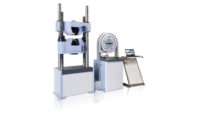
The quality field of nondestructive testing (NDT) has come a long way since the first primitive but successful applications of the liquid penetrant inspection method (LPI) were used by the railroad industry in the late 19th century. That is when it was discovered that the “oil and whiting” method, which utilized old machine oil and powdered chalk, could reveal surface defects in railcar axles, couplers and locomotive boiler parts.
Since that simple inception, continuous improvements in LPI process equipment, materials, techniques, and personnel training and qualification have helped it to keep pace with the changing needs of the aerospace industry, and manufacturing in general. The basic principles of liquid penetrant inspection and their application, however, are much the same today as they were in the beginning.
The process is not high-technology dependent-unless one considers a mercury vapor light bulb with a glass UV filter high-tech-compared to most other later developed NDT methods such as radiography, ultrasonics, magnetic resonance, infrared thermography and laser-based applications.
General principles of liquid penetrant inspection are, and always have been:
1. The idea that an object of almost any alloy or nonporous makeup, of almost any configuration can be tested for the presence of surface flaws by coating it with a penetrating fluid long enough for the fluid to penetrate into any existing surface flaws or discontinuities. The test surface should be clean, bare and unsmeared beforehand to allow this to effectively occur.
2. The idea that the penetrant fluid characteristics will allow subsequent removal of all excess penetrant from the test part by appropriate methods, such as solvent wipe or controlled water wash, without removing any of the penetrant held by discontinuities.
3. The idea that this liquid penetrant remaining within discontinuities can be made to “bleed out” by application of developer materials (fine powders) to form indications of flaws for easy detection and evaluation by a trained inspector. This can happen by using color contrast (visible dye) penetrants or very bright fluorescent penetrants which respond to long-wave, nonharmful ultraviolet illumination (blacklight).
4. This test method can be performed at low cost almost anywhere on almost any complex shape in a wide range of environmental conditions, without harm to the test items. Residues of penetrant test materials are easily removed from test surfaces.
Aerospace Application
The need for reliable, cost-effective detection of specific surface flaws in aerospace components includes but is not limited to:1. Linear discontinuities–down to 0.02 inch length or smaller–cracks of all types, seams, laps, laminations, machine or forming tears, cold shuts and shrinkage (castings) die drag, inclusions, lack of weld fusion.
2. Non-linears–gas holes, excessive porosity, corrosion pits, blisters, flakes and bursts.
The answer is to perform fluorescent penetrant inspection, water-washable method, per the following process sequence.
1. Prepare and pre-clean part surface as required.
2. Apply water-washable fluorescent penetrant to test part for the required time interval.
3. Remove excess penetrant - water-wash.
4. Dry part, and then apply powder developer for required time interval.
5. Inspect developed part in suitably darkened area under UV light.
6. Interpret and evaluate any indications (areas of fluorescence on the test part) per applicable acceptance criteria.
7. Document inspection results.
8. Post-clean part to remove penetrant material residues.
LPI Process Changes and Improvements
In the late 1950s, the “post-emulsifi-cation” (PE) process for LPI was developed to be the most sensitive, most reliable method for revealing very small or wide and shallow discontinuities in fracture critical components such as jet engine turbine blades. Today, refinements in easier-to-use water-washable penetrants-to sensitivity levels of high and ultrahigh-have brought their effectiveness and reliability alongside post-emulsification materials, and may soon render the PE process obsolete.A range of penetrant products are now available that allow the penetrant process to be adapted to the characteristics of the part being tested. For instance, one can select penetrant materials that will produce a sensitivity level to match, or be most compatible with, the material soundness requirements of the test parts.
The establishment of regularly performed process control checks to validate a penetrant inspection, per application requirements, allows NDT personnel to closely gage, monitor and document changes in a system’s sensitivity and overall performance.
Inspectors have benefitted from the use of lighter, yet more rugged materials incorporated in newer designs of ultraviolet inspection lamps and blacklight viewing equipment.
The value of worldwide standardization of LPI process requirements is widely recognized. The achievement of such is a work in progress.
Most of the NDT methods in use today are sophisticated, technology-dependent and relatively expensive. They can achieve much that penetrant inspection cannot. But it is because of LPI’s economy, simplicity and ease of application that the reverse also is true.
After 30 years of daily practice of inspecting aerospace components for flaws under a blacklight, I wonder when some high-tech method will pop up to take its place. Until that happens, companies are able to successfully carry on with the basics.
